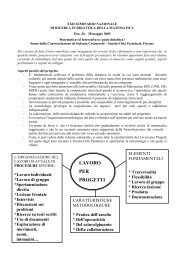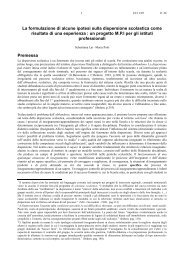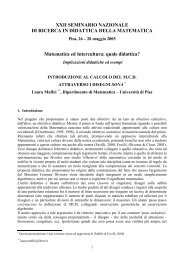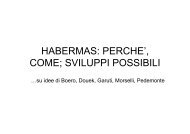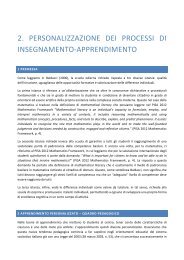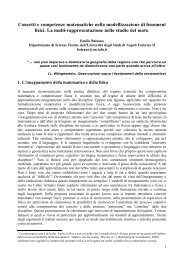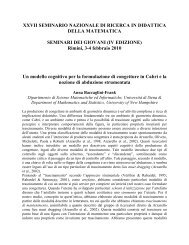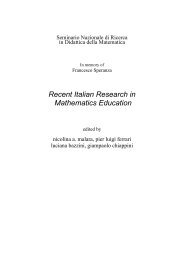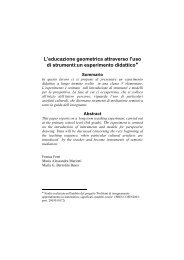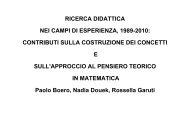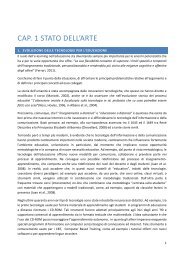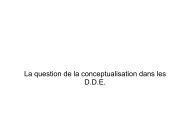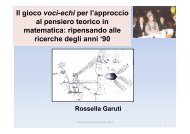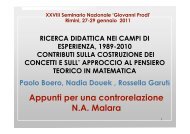vygotsky's everyday concepts/scientific concepts dialectics in school ...
vygotsky's everyday concepts/scientific concepts dialectics in school ...
vygotsky's everyday concepts/scientific concepts dialectics in school ...
Create successful ePaper yourself
Turn your PDF publications into a flip-book with our unique Google optimized e-Paper software.
and to compare heights of two plants. The closeness between the <strong>concepts</strong> of height<br />
and <strong>in</strong>crease added complexity. However, it will be <strong>in</strong>terest<strong>in</strong>g to see how the<br />
evolution of the conceptualisation of <strong>in</strong>crease depended on, and simultaneously<br />
favoured, the mastery of the additive field and its extension to <strong>in</strong>clude the comparison<br />
of transformations.<br />
Phase 1: Individual oral production with teacher’s mediation<br />
13 students (out of 20) engaged correctly <strong>in</strong>to the problem solv<strong>in</strong>g, through<br />
calculations and comparison of results. But they were confused when the teacher<br />
asked them to expla<strong>in</strong> their problem solv<strong>in</strong>g. Only 6 of them arrived easily at a stable<br />
correct conclusion. Some students answered “the plant that <strong>in</strong>creased the most is the<br />
one which is the tallest”. They deduced <strong>in</strong>crease from height, thus contradict<strong>in</strong>g their<br />
own numerical result. Others said “this plant <strong>in</strong>creased the most, so it is the tallest”.<br />
They deduced height from <strong>in</strong>crease, disregard<strong>in</strong>g the visible state of the plants.<br />
Perform<strong>in</strong>g the right calculations was not enough to grasp the situation as a whole. To<br />
solve problem numerically, most students <strong>in</strong>terpreted <strong>in</strong>crease as a supplementary<br />
length <strong>in</strong> the plant. But the dynamical character of <strong>in</strong>crease was not grasped with its<br />
dependence on time and the implicit fact that it may be slow or quick between two<br />
given moments: they were not able to use such an argument to <strong>in</strong>terpret the situation.<br />
Their <strong>everyday</strong> conceptualisation of <strong>in</strong>crease was not sufficient. But through<br />
argumentation guided (or stimulated, depend<strong>in</strong>g on cases) by the teacher, this concept<br />
evolved and most students became able, at least momentarily, to handle the problem<br />
situation through verbal activity, pay<strong>in</strong>g attention to the various elements of the<br />
situation, and were able to <strong>in</strong>terpret them accord<strong>in</strong>g to a hierarchy that organised<br />
calculations. Many students used an expression that became mean<strong>in</strong>gful and<br />
stabilised: “pezzo cresciuto” ("the bit that grew").<br />
The other 7 students had difficulties to master and <strong>in</strong>terpret data, and did not succeed<br />
<strong>in</strong> produc<strong>in</strong>g a solution. The teacher encouraged them (as well as 2 students out of the<br />
group of 13 who had produced a correct solution) to draw the two plants, mark the<br />
draw<strong>in</strong>g with signs correspond<strong>in</strong>g to the different heights at different dates, and<br />
follow the <strong>in</strong>creases on the draw<strong>in</strong>g. Hence for all the students the situation ga<strong>in</strong>ed a<br />
spatial character, either through the draw<strong>in</strong>g or through the image of “the bit that<br />
grew” (which is not correct <strong>scientific</strong>ally, s<strong>in</strong>ce growth is an evolution of the whole<br />
plant). This spatial frame helped most students to “see” and grasp the dynamical<br />
aspect of the plant grow<strong>in</strong>g as well as to fix for each plant the elements that need to<br />
be determ<strong>in</strong>ed and compared. Given students' mastery of the additive field, I<br />
conjecture that those spatial representations allowed the representation of numbers on<br />
the number l<strong>in</strong>e to be transferred (gradually, depend<strong>in</strong>g on students) to this new<br />
additive situation. This favoured the mathematisation of this new situation while<br />
putt<strong>in</strong>g its dynamical character <strong>in</strong>to new evidence.<br />
As a whole, student/teacher <strong>in</strong>teractions developed argumentation concern<strong>in</strong>g three<br />
types of references: reality of plants cultivation, their “stories” with their dynamical<br />
character and time dependence; schematisation through draw<strong>in</strong>g and/or its equivalent



